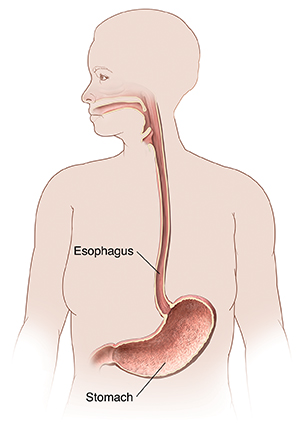Understanding a Schatzki Ring
A Schatzki ring is a thin ring of extra tissue inside the lower end of the esophagus. The esophagus is the tube that food travels down from your mouth to your stomach. The ring can occur in the part of the tube near the stomach. It can stop the esophagus from stretching normally. This can make it hard to swallow foods.

What causes a Schatzki ring?
Researchers aren’t sure exactly what causes it. But gastroesophageal reflux disease (GERD) may be a cause. GERD is when acid and other stomach contents flow up into the esophagus. This can cause the inside of the esophagus to be inflamed.
People with Schatzki ring may also have:
-
Hiatal hernia. This is a condition where the top of the stomach sometimes slides up through the natural opening in the diaphragm. The diaphragm is the thin muscle in the upper abdomen. A hiatal hernia can cause reflux of your stomach contents into the esophagus. Many people with a Schatzki ring also have a hiatal hernia.
-
Eosinophilic esophagitis. This is an immune system condition. It causes ongoing (chronic) inflammation of the esophagus. Some people with Schatzki ring also have this condition.
Much less commonly, Schatzki ring can occur in people who have a rare condition called Plummer-Vinson syndrome. This is caused by untreated, severe iron-deficiency anemia. It can cause esophageal webs. This is thin tissue that grows across part of the upper esophagus .
Symptoms of a Schatzki ring
The ring often does not cause symptoms. In people with symptoms, it may cause trouble swallowing (dysphagia). You may have:
-
Trouble swallowing food, such as meats, chewy bread, and large bites
-
Trouble swallowing pills
-
Trouble swallowing liquids, in severe cases
-
Pain or discomfort in the chest after swallowing food
-
Vomiting after eating
Diagnosing a Schatzki ring
Your healthcare provider will ask about your symptoms and medical history. You may also have tests, such as:
-
Barium swallow (esophagram). For this test, you swallow liquid or pills that have barium. This provides contrast. X-ray images are taken of your esophagus.
-
Upper endoscopy. This test is done with a flexible tube (scope) with a camera. The scope is put down into your mouth to the esophagus to see and take pictures. Small pieces of tissue make be taken for testing (biopsy).
Treatment for a Schatzki ring
Treatment will depend on your symptoms, your age, and your general health. It will also depend on how severe the condition is. Treatment may include:
-
Acid-blocker medicine. You may be given medicine to decrease your stomach acid. This type of medicine is called a proton pump inhibitor (PPI) or H2 blocker.
-
Dilation. While you are sedated, a flexible scope is put down into your esophagus. The healthcare provider uses the scope to dilate and break up the tissue of the ring.
Talk with your healthcare providers about the risks, benefits, and possible side effects of all treatments. A Schatzki ring can come back a year or more after treatment. You may need to be treated again.
You may also be able to ease your symptoms by:
-
Eating small bites of food
-
Chewing food completely before you swallow
-
Not eating meat that is tough
-
Not swallowing large bites of food
Possible complications of a Schatzki ring
In rare cases, food that is stuck for a while in the esophagus may cause a tear in the esophagus.
When to call your healthcare provider
Call your healthcare provider right away if you have any of these:
Online Medical Reviewer:
Jen Lehrer MD
Online Medical Reviewer:
L Renee Watson MSN RN
Online Medical Reviewer:
Rita Sather RN
Date Last Reviewed:
1/1/2022
© 2000-2025 The StayWell Company, LLC. All rights reserved. This information is not intended as a substitute for professional medical care. Always follow your healthcare professional's instructions.